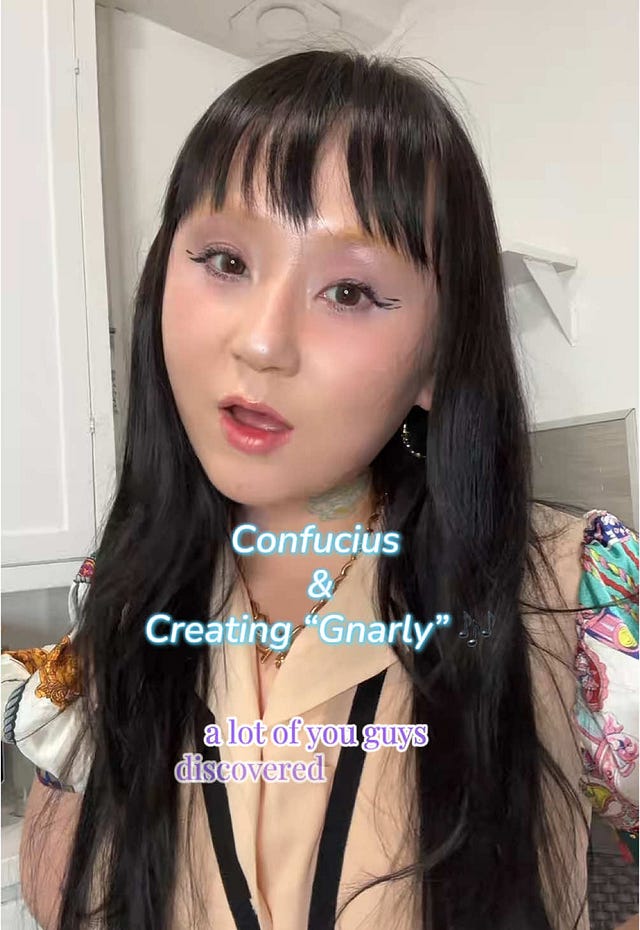what it actually takes to make a k-pop song
welcome to strong feelings! Essays by writers we love, in which they share their most impassioned opinions on a given subject. In today’s strong feelings, writer Steffi explores how K-pop songs actually get made.
Since April 30, K-pop and pop stan accounts have been abuzz with discourse, after global girl group KATSEYE dropped the hyperpop track “Gnarly.”
“Making beats, for a boring dumb bitch, fucking gnarly, don’t talk to me,” member Lara Raj whines over the gritty instrumental.
It was certainly a departure from the group’s work thus far — which the members acknowledged ahead of its release — but the response online and among fans was truly staggering. Within a week, posts about the song swerved from a vitriolic gavel bang of “thanks, we hate it” to “you just don’t get it” before anyone could even figure out what the hype was even about. “Gnarly” left much room for interpretation and therefore discourse — namely, the braggadocious, seemingly arbitrary lyrics that mention global loser Elon Musk’s Tesla in the good year of 2025 (they have since performed a version that replaces Tesla with “robotics”).
The verse “hottie hottie, like a bag of Takis (I’m the shit)” begged the question of if the lyrics were intending to insert a double entendre, to the effect of being so sexy that it was giving all six girls collective diarrhea (which, said with the most amount of respect and admiration, is gnarly as fuck). Yes, compared to the simple, sweet soundscapes on their debut EP SIS (Soft Is Strong), “Gnarly” is certainly more off-putting, and simultaneously cooler, at first listen. And as time has gone on, it has become clear that the people are on board with their weird shit.
There is often debate among fans, particularly surrounding the well-oiled machine of K-pop, about who should take the credit when a bizarre song hits the public. We’ve seen this many times over, with NMIXX’s debut song “O.O,” NCT 127’s “Sticker,” or Itzy’s “Sneakers.” Fans understand that there is a larger team behind the production, but it’s often a matter of argument as to who must take the fall for their disappointment, excitement, or general confusion.
Of course, this kind of pop culture shock isn’t new. Pop stars steering their creative identity towards something sexier and more adult has often become the center of backlash before an ultimate revisionist history in favor of it; look no further than Miley Cyrus’ “Can’t Be Tamed” or Britney Spears’ graduation from…Baby One More Time to Oops!... I Did It Again. These iconic pop stars shouldered the majority of the blame themselves, but in K-pop — an industry so proud of identifying itself as a multi-tentacled marketing machine — the fans also tend to blame the silhouettes behind the curtain.
The response to “Gnarly” has been funny in that sense. In the week of Hating It, fans pointed fingers at everyone from HYBE to composer Alice Longyu Gao, an artist who has made her mark in the world of high-octane, metallic, alternative-pop sound. It’s clear that no one knew exactly who to blame for their dismay at the release, so everyone got some hate, which only served to spur the conversation around it.
No one is able to discern what qualifies as artistic identity from the stars they pay money to hear and what is the product of a publicity team’s focus group research, so they tend to make those delineations for themselves. There’s some intrinsic feeling that K-pop music is being made in an industrial kiln, so when something feels off-kilter from the usual factory settings, the hate is loud and decisive. And just as quickly as the hate came, it disappeared — right when the earworm became just undeniable enough. No one grasped “Gnarly” as an intentional pivot, and we all fell down the consumer conversion funnel once more.
All of this means that it’s difficult for anyone to have a critical conversation about the state of K-pop today without a Wonyoung stan account blasting your coordinates across a billboard in Times Square. But today I would like to try to lift the veil:
So, what actually happens in the making of a K-pop song? Generally, from the perspective of the artists and repertoire (A&R) team, the stages can be broken down into the following: project concept, style and rough timeline, demo solicitation, recording materials with the artist, finishing all demos, mixing and mastering, legal clearing, and marketing and release.
 Tiktok failed to load.
Tiktok failed to load.Enable 3rd party cookies or use another browser
Zayson, a songwriter and producer who’s worked on tracks with artists like NCT and The Boyz, explains that while traditionally producers are paired with songwriters who then write over the producer’s track (this is called “topline writing”), the roles are increasingly overlapping. “More and more songwriters are recording and engineering their own vocals for the demo, whereas it probably used to be handled more often by the producer,” he tells mixed feelings.
After sketching out the instrumental, creating the central architecture of the song, and sending it off to labels, it’s not always guaranteed if the work will have a future. “From there, you may never hear back about your precious song,” he says. “If a miracle happens and you do hear back, a label may reach out to request to hold your song for a period of time while they consider it (and it can no longer be pitched elsewhere in the meantime) or even better, they reach out to buy the song. There may be multiple rounds of revisions to either the track or the topline until final confirmation.”
“I think [K-pop companies] tend to need each 4-bar section in a song to be a special moment, whereas non K-pop label artists might not need that.”
After confirmation, this is when the artist would enter the picture. Zayson says at this point, Korean lyricists are hired on board to make a Korean version based on the English demo lyrics, and then the artist records the song, after which it goes through the “real stage of mixing” and mastering. “If everything goes smoothly, it actually gets released and we can celebrate this miracle,” he says.
A songwriter and producer based in Los Angeles, who asked to remain anonymous for privacy reasons, said that working with K-pop companies and Western companies is often a very different experience — the main contrast being the amount of freedom that they’re looking for in the creative process. “K-pop companies usually have very specific goals and references,” they tell mixed feelings. “They would send decks to other labels and producers with all of their artists’ release plan details included.”
The release plan often goes into very specific detail about what the company is looking for, including not just how many songs the company wants on the group’s EP or album, but also what kinds of songs they want on the project — a dance pop track, a ballad, a club beat. Often this will come with references to other songs, attached via YouTube links. It’s at this stage that producers will pitch suitable demos back to the label, which then sends said demo to songwriters to solicit lyrics.
All of this is happening from their bedroom, where they make all of their songs. It’s not always a big-budget studio. Zayson says that the vibe is often quite intimate if he’s collaborating with other people. “Company studios have the budget, so they’re the nice fancy ones you probably see online when artists shoot recording/writing footage,” he says. “Personal studios are a lot more varied depending on the producer/writer, filled with personal objects unique to the owner, and probably a lot of iced americano take-out cups—at least in Seoul.”
The producer also explains that the reason that fans can see upwards of ten songwriters around the world behind one song often comes from this demo stage as well — they’re not always collaborating in one room together. “K-pop companies might also send one demo to several songwriters to get different toplines and lyrics. They would put a sound watermark — like your producer tag on the track rendered with an AI voice so that you wouldn't leak the demo,” they say.
There’s also structural differences that the companies tend to look for. “I would imagine K-pop companies have to get a lot more detailed and picky with revisions because they tend to have artist groups with many members who all deserve their moment to shine within one song,” Zayson says. “I think [K-pop companies] tend to need each 4-bar section in a song to be a special moment, whereas non K-pop label artists might not need that.”
The LA-based producer says that the restrictions aren’t always a bad thing. “To write for other artists is usually more fun because it involves less ego,” the producer says. “I feel less pressure when writing for others.”
While demo solicitation is also a common practice in the US music industry, the producer says they haven’t seen as detailed instructions from Western labels. “That encourages more creativity than experience,” they say. “More often, labels would arrange sessions for producers and artists to gather together and sketch some ideas together. Producers and their labels pitching demos to artists is also quite common.”
At the end of the day, the amount songwriters earn can vary greatly. “The range is absurdly wide depending on the song,” Zayson says. “Sometimes nothing, sometimes a couple months’ rent, sometimes enough to buy a decent car.”
Figuring out what will resonate with others, and getting a sense for what the audience thinks a “good” song sounds like, is the hard part, says Zayson.
“While music is subjective, when considering music for commercial release, there are certain expectations and standards that people subconsciously use to make a judgment on a song,” he says. “The more you create and pay attention to how listeners react to music, the more you might pick up on what makes most people think this song is well-made, even if it might not be their taste. Honing that sense, knowing what decisions to make throughout the process…is a lifelong journey.”








